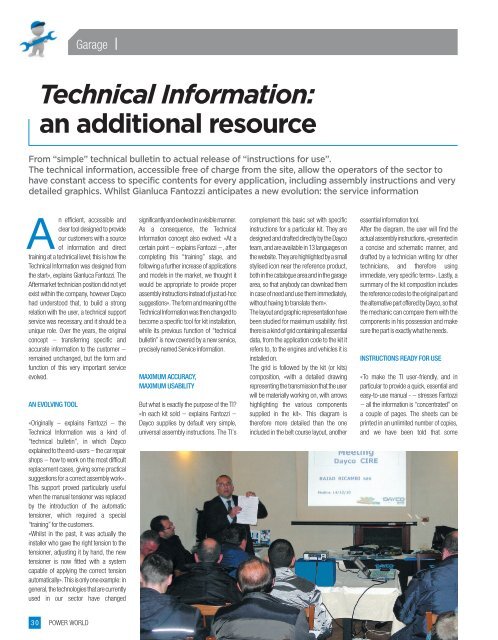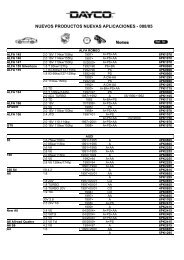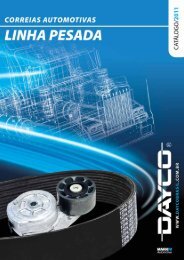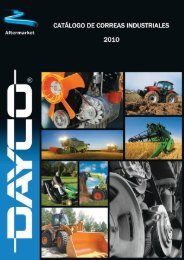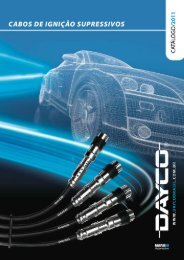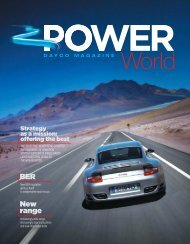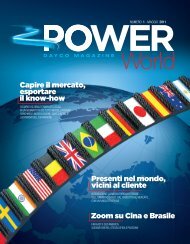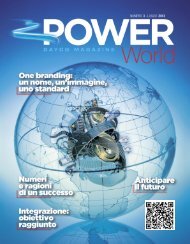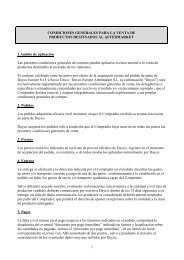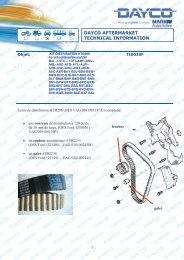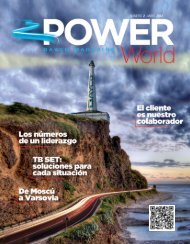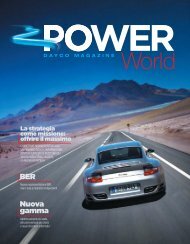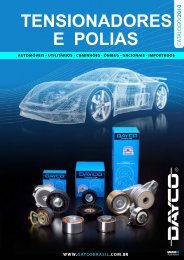PDF, 13Mb - Dayco
PDF, 13Mb - Dayco
PDF, 13Mb - Dayco
Create successful ePaper yourself
Turn your PDF publications into a flip-book with our unique Google optimized e-Paper software.
Garage<br />
Technical Information:<br />
an additional resource<br />
From “simple” technical bulletin to actual release of “instructions for use”.<br />
The technical information, accessible free of charge from the site, allow the operators of the sector to<br />
have constant access to specific contents for every application, including assembly instructions and very<br />
detailed graphics. Whilst Gianluca Fantozzi anticipates a new evolution: the service information<br />
An efficient, accessible and<br />
clear tool designed to provide<br />
our customers with a source<br />
of information and direct<br />
training at a technical level; this is how the<br />
Technical Information was designed from<br />
the start», explains Gianluca Fantozzi. The<br />
Aftermarket technician position did not yet<br />
exist within the company, however <strong>Dayco</strong><br />
had understood that, to build a strong<br />
relation with the user, a technical support<br />
service was necessary, and it should be a<br />
unique role. Over the years, the original<br />
concept – transferring specific and<br />
accurate information to the customer –<br />
remained unchanged, but the form and<br />
function of this very important service<br />
evolved.<br />
AN EVOLVING TOOL<br />
«Originally – explains Fantozzi – the<br />
Technical Information was a kind of<br />
“technical bulletin”, in which <strong>Dayco</strong><br />
explained to the end-users – the car repair<br />
shops – how to work on the most difficult<br />
replacement cases, giving some practical<br />
suggestions for a correct assembly work».<br />
This support proved particularly useful<br />
when the manual tensioner was replaced<br />
by the introduction of the automatic<br />
tensioner, which required a special<br />
“training” for the customers.<br />
«Whilst in the past, it was actually the<br />
installer who gave the right tension to the<br />
tensioner, adjusting it by hand, the new<br />
tensioner is now fitted with a system<br />
capable of applying the correct tension<br />
automatically». This is only one example: in<br />
general, the technologies that are currently<br />
used in our sector have changed<br />
significantly and evolved in a visible manner.<br />
As a consequence, the Technical<br />
Information concept also evolved: «At a<br />
certain point – explains Fantozzi –, after<br />
completing this “training” stage, and<br />
following a further increase of applications<br />
and models in the market, we thought it<br />
would be appropriate to provide proper<br />
assembly instructions instead of just ad-hoc<br />
suggestions». The form and meaning of the<br />
Technical Information was then changed to<br />
become a specific tool for kit installation,<br />
while its previous function of “technical<br />
bulletin” is now covered by a new service,<br />
precisely named Service information.<br />
MAXIMUM ACCURACY,<br />
MAXIMUM USABILITY<br />
But what is exactly the purpose of the TI<br />
«In each kit sold – explains Fantozzi –<br />
<strong>Dayco</strong> supplies by default very simple,<br />
universal assembly instructions. The TI’s<br />
complement this basic set with specific<br />
instructions for a particular kit. They are<br />
designed and drafted directly by the <strong>Dayco</strong><br />
team, and are available in 13 languages on<br />
the website. They are highlighted by a small<br />
stylised icon near the reference product,<br />
both in the catalogue area and in the garage<br />
area, so that anybody can download them<br />
in case of need and use them immediately,<br />
without having to translate them».<br />
The layout and graphic representation have<br />
been studied for maximum usability: first<br />
there is a kind of grid containing all essential<br />
data, from the application code to the kit it<br />
refers to, to the engines and vehicles it is<br />
installed on.<br />
The grid is followed by the kit (or kits)<br />
composition, «with a detailed drawing<br />
representing the transmission that the user<br />
will be materially working on, with arrows<br />
highlighting the various components<br />
supplied in the kit». This diagram is<br />
therefore more detailed than the one<br />
included in the belt course layout, another<br />
essential information tool.<br />
After the diagram, the user will find the<br />
actual assembly instructions, «presented in<br />
a concise and schematic manner, and<br />
drafted by a technician writing for other<br />
technicians, and therefore using<br />
immediate, very specific terms». Lastly, a<br />
summary of the kit composition includes<br />
the reference codes to the original part and<br />
the alternative part offered by <strong>Dayco</strong>, so that<br />
the mechanic can compare them with the<br />
components in his possession and make<br />
sure the part is exactly what he needs.<br />
INSTRUCTIONS READY FOR USE<br />
«To make the TI user-friendly, and in<br />
particular to provide a quick, essential and<br />
easy-to-use manual - – stresses Fantozzi<br />
– all the information is “concentrated” on<br />
a couple of pages. The sheets can be<br />
printed in an unlimited number of copies,<br />
and we have been told that some<br />
3 0 POWER WORLD


